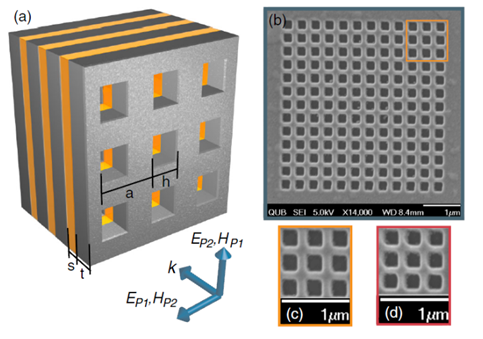Metamaterials step into the light
April 27, 2012 | Source: IEEE Spectrum

(a) Schematic of a fishnet metamaterial made up of three unit cells in the propagation direction with layers (4 metal layers and 3 dielectric layers). (b) Top-view SEM image of the fabricated 3-unit-cell fishnet structure. (c) Detail of image in (b). (d) Detail of the fabricated 3-unit-cell fishnet structure. (Credit: Carlos Garcia-Meca)
Scientists in England and Valencia, Spain, have constructed what may be the first practical metamaterial that manipulates visible light.
The researchers predict it could be used for subpicosecond (less than a trillionth of a second) optical switches and finely controlled laser pulses. The layered structure, in contrast to the makeup of earlier visible-light devices, means it can conceivably be built up into a usable, full-size object.
However, not everyone is convinced this is possible.
The researchers laid down alternating 15- to 35-nanometer-thick layers of silver and hydrogen silsesquioxane (a type of glass). They then etched rectangular holes through the layers with a focused ion beam to make a structure that looks something like a fishnet.
This “nanofishnet” structure has become a standard arrangement in metamaterials, with each hole acting as an artificial atom. But Garcia-Meca says his group’s nanofishnet has two unprecedented features: its multilayer composition and its use of second-order magnetic resonance to create negative magnetic permeability for red and near-infrared light.
The group was able to adjust the material’s index of refraction for different wavelengths of lighjt simply by varying the size of the holes in the fishnet.
Ref.: C. García-Meca et al., Low-Loss Multilayered Metamaterial Exhibiting a Negative Index of Refraction at Visible Wavelengths, Physical Review Letters, 2011, [DOI: 10.1103/PhysRevLett.106.067402]
Ref.: Costas M. Soukoulis and Martin Wegener, Past achievements and future challenges in the development of three-dimensional photonic metamaterials, Nature Photonics, 2011 [DOI: 10.1038/nphoton.2011.154]
Ref.: Costas M. Soukoulis and Martin Wegener, Past Achievements and Future Challenges in 3D Photonic Metamaterials, arxiv:1109.0084